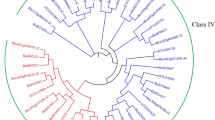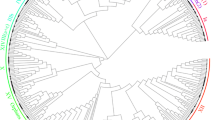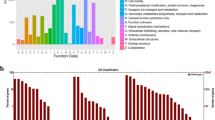Abstract
Chitinases are a diverse group of enzymes having the ability to degrade chitin. Chitin is the second most abundant polysaccharide on earth, predominantly found in insect exoskeletons and fungal cell walls. In this study, we performed a genome-wide search for chitinase genes and identified a total of 49 chitinases in tea. These genes were categorized into 5 classes, where an expansion of class V chitinases has been observed in comparison to other plant species. Extensive loss of introns in 46% of the GH18 chitinases indicates that an evolutionary pressure is acting upon these genes to lose introns for rapid gene expression. The promoter upstream regions in 65% of the predicted chitinases contain methyl-jasmonate, salicylic acid and defense responsive cis-acting elements, which may further illustrate the possible role of chitinases in tea plant’s defense against various pests and pathogens. Differential expression analysis revealed that transcripts of two GH19 chitinases TEA028279 and TEA019397 got upregulated during three different fungal infections in tea. While GH19 chitinase TEA031377 showed an increase in transcript abundance in the two insect infested tea tissues. Semi-quantitative RT-PCR analysis revealed that five GH19 chitinases viz. TEA018892, TEA031484, TEA28279, TEA033470 and TEA031277 showed significant increase in expression in the tea plants challenged with a biotrophic pathogen Exobasidium vexans. The study endeavours in highlighting biotic stress responsive defensive role of chitinase genes in tea.









Similar content being viewed by others
Data availability
All the SRA data samples were downloaded from NCBI SRA database (https://www.ncbi.nlm.nih.gov/sra/). The chitinase gene sequences of tea were downloaded from Tea Plant Information Archive (TPIA) database (http://tpia.teaplant.org/). The chitinase protein sequences of Arabidopsis were downloaded from The Arabidopsis Information Resource (TAIR) (https://www.arabidopsis.org/).
References
Abeles FB, Bosshart RP, Forrence LE, Habig WH (1970) Preparation and purification of glucanase and chitinase from bean leaves. Plant Physiol 47:129–134
Agnihothrudu V (1964) Notes on fungi from north-east India—XXII some species of hypoxylon from Assam. Mycopathologia et Mycologia Applicata 23:111–117
Amian AA, Papenbrock J, Jacobsen HJ, Hassan F (2011) Enhancing transgenic pea (Pisum sativum L.) resistance against fungal diseases through stacking of two antifungal genes (Chitinase and Glucanase). GM Crops 2:104–109
Anders S, Huber W (2010) Differential expression analysis for sequence countdata. Genome Biol 11:R106
Araki T, Torikata T (1995) Structural classification of plant chitinases: two subclasses in class I and class II chitinases. Biosci Biotechnol Biochem 59:336–338
Baby UI, Ravichandran R, Ganesan V, Parthiban R, Sukumar S (1998) Effect of blister blight disease on the biochemical and quality constituents of green leaf and CTC tea. Trop Agric 75(4):452–456
Bailey TL, Boden M, Buske FA, Frith M, Grant CE, Clementi L, Noble WS (2009) MEME SUITE: tools for motif discovery and searching. Nucleic Acids Res 37:W202–W208
Bartnicki-Garcia S (1968) Cell wall chemistry, morphogenesis and taxonomy of fungi. Annu Rev Microbiol 22:87–108
Bendtsen JD, Nielsen H, Heijne GV, Brunak S (2004) Improved prediction of signal peptides: SignalP 3.0. J Mol Biol 340:783–795
Bhorali P, Gohain B, Gupta S et al (2012) Molecular analysis and expression profiling of blister blight defense related genes in tea. Indian J Genet Plant Breed 72:226–233
Borah AK, Singh A, Yasmin R et al (2019) 1α, 25-dihydroxy Vitamin D3 containing fractions of Catharanthus roseus leaf aqueous extract inhibit preadipocyte differentiation and induce lipolysis in 3T3-L1 cells. BMC Complement Altern Med 19:338
Borchetia S, Handique G, Roy S, Wani SH (2018) Genomics approaches for biotic and abiotic stress improvement in tea. In: Stress physiology of tea in the face of climate change, pp 289–312
Bordoloi KS, Dihingia P, Krishnatreya DB, Agarwala N (2021) Genome-wide identification, characterization and expression analysis of the expansin gene family under drought stress in tea (Camellia sinensis L.). Plant Sci Today 8(1):32–44
Broekgaarden C, Caarls L, Vos IA, Pieterse CMJ, Wees SCMV (2015) Ethylene: traffic controller on hormonal crossroads to defense. Plant Physiol 169:2371–2379
Caarls L, Does DVD, Hickman R, Jansen W, Verk MCV, Proietti S, Lorenzo O, Solano R, Pieterse CMJ, Wees SCMV (2017) Assessing the role of ethylene response factor transcriptional repressors in salicylic acid-mediated suppression of Jasmonic acid-responsive genes. Plant Cell Physiol 58(2):266–278
Cao J, Tan X (2019) Comprehensive analysis of the chitinase family genes in tomato (Solanumlycopersicum). Plants 8:52
Cao S, Wang Y, Li Z, Shi X, Gao F, Zhou Y, Zhang G, Feng J (2019) Genome-wide identification and expression analyses of the chitinases under cold and osmotic stress in Ammopiptanthus nanus. Genes 10:472
Chen ZM, Chen XF (1990) The diagnosis of tea diseases and their control. Shanghai Scientific and Technical Publishers, Shanghai
Chen J, Piao Y, Liu Y, Li X, Piao Z (2018) Genome-wide identification and expression analysis of chitinase gene family in Brassica rapa reveals its role in clubroot resistance. Plant Sci 270:257–267
Collinge DB, Kragh KM, Mikkelsen JD, Nielsen KK, Rasmussen U, Vad K (1993) Plant chitinases. Plant J 3:31–40
Dana M, Pintor-Toro JA, Cubero B (2006) Transgenic tobacco plants overexpressing chitinases of fungal origin show enhanced resistance to biotic and abiotic stress agents. Plant Physiol 142:722–730
El-Gebali S, Mistry J, Bateman A, Eddy SR, Luciani A, Potter SC, Qureshi M, Richardson LJ, Salazar GA, Smart A et al (2019) The Pfam protein families database in 2019. Nucleic Acids Res 47:D427–D432
Finn RD, Clements J, Eddy SR (2011) HMMER web server: interactive sequence similarity searching. Nucleic Acids Res 39:W29–W37
Gasteiger E, Hoogland C, Gattiker A, Duvaud S, Wilkins MR, Appel RD, Bairoch A (2005) Protein identification and analysis tools on the ExPASy server. In: Walker JM, Totowa NJ (eds) The proteomics protocols handbook. Humana Press, Totowa
Gohain B, Borchetia S, Bhorali P, Agarwal N, Bhuyan LP, Rahman A, Sakata K, Mizutani M, Shimizu B, Gurusubramaniam G, Ravindranath R, Kalita M, Hazarika M, Das S (2012) Understanding Darjeeling tea flavour on a molecular basis. Plant Mol Biol 78(6):577–597
Goodstein DM, Shu SQ, Howson R, Neupane R, Hayes RD, Fazo J et al (2012) Phytozome: a comparative platform for green plant genomics. Nucleic Acids Res 40:D1178–D1186
Grover A (2012) Plant chitinases: genetic diversity and physiological roles. Crit Rev Plant Sci 31:57–73
Hamel F, Boivin R, Tremblay C, Bellemare G (1997) Structural and evolutionary relationships among chitinases of flowering plants. J Mol Evol 44:614–624
Heitz T, Segond S, Kauffmann S, Geoffroy P, Prasad V, Brunner F, Fritig B, Legrand M (1994) Molecular characterization of a novel tobacco pathogenesis-related (PR) protein: a new plant chitinase/lysozyme. Mol Gen Genet 245:246–254
Higo K, Ugawa Y, Iwamoto M, Korenaga T (1999) Plant cis-acting regulatory DNA elements (PLACE) database: 1999. Nucleic Acids Res 27:297–300
Hu B, Jin J, Guo AY, Zhang H, Luo J, Gao G (2015) GSDS 2.0: an upgraded gene feature visualization server. Bioinformatics 31:1296–1297
Jayaswall K, Mahajan P, Singh G et al (2016) Transcriptome analysis reveals candidate genes involved in blister blight defense in tea (Camellia sinensis (L) Kuntze). Sci Rep 6:1–14
Jeffares DC, Penkett CJ, Bähler J (2008) Rapidly regulated genes are intron poor. Trends Genet 24:375–378
Jiang C, Huang RF, Song JL, Huang MR, Xu LA (2013) Genome wide analysis of the chitinase gene family in Populus trichocarpa. J Genet 92:121–125
Kasprzewska A (2003) Plant chitinases-regulation and function. Cell Mol Biol Lett 8:809–824
Kumar S, Stecher G, Li M, Knyaz C, Tamura K (2018) MEGA X: molecular evolutionary genetics analysis across computing platforms. Mol Biol Evol 35(6):1547–1549
Lescot M, Déhais P, Thijs G, Marchal K, Moreau Y, Van de Peer Y, Rouzé P, Rombauts S (2002) PlantCARE, a database of plant cis-acting regulatory elements and a portal to tools for in silico analysis of promoter sequences. Nucleic Acids Res 30:325–327
Li X, Roseman S (2004) Thechitinolytic cascade in Vibrios is regulated bychitin oligosaccharides and a two-component chitin catabolic sensor/kinase. Proc Natl Acad Sci USA 101:627–631
Mackintosh C, Lewis J, Radmer L, Shin S, Heinen S, Smith L, Wyckoff M, Dill-Macky R, Evans C, Kravchenko S, Baldridge G, Zeyen R, Muehlbauer G (2007) Overexpression of defense response genes in transgenic wheat enhances resistance to Fusarium head blight. Plant Cell Rep 26:479–488
Metsalu T, Vilo J (2015) ClustVis: a web tool for visualizing clustering of multivariate data using principal component analysis and heatmap. Nucleic Acids Res 43:W566–W570
Misra BB (2015) Molecular evolution and functional divergence of chitinase gene family in Hevea brasiliensis genome, vol 6. The Winnower, New York
Mondal K, Bhattacharya R, Koundal K, Chatterjee S (2007) Transgenic Indian mustard (Brassica juncea) expressing tomato glucanase leads to arrested growth of Alternaria brassicae. Plant Cell Rep 26:247–252
Mukhopadhyay M, Mondal TK, Chand PK (2016) Biotechnological advances in tea (Camellia sinensis [L.] O. Kuntze): a review. Plant Cell Rep 35(2):255–287
Neuhaus JM, Fritig B, Linthorst HJM, Meins F, Mikkelsen JD, Ryals J (1996) A revised nomenclature for chitinase genes. Plant Mol Biol Rep 14:102–104
Nicholas KB, Nicholas Jr, HB (1997) GeneDoc: a tool for editing and annotating multiple sequence alignments
Nong VH, Schlesier B, Bassüner R, Repik A, Hortsmann C, Müntz K (1995) Narbonin, a novel 2S protein from Vicia narbonensis L. seed: cDNA, gene structure and developmentally regulated formation. Plant Mol Biol 28:61–72
Passarinho PA, de Vries SC (2002) Arabidopsis chitinases: a genomic survey. Arab Book/Am Soc Plant Biol 1:e0023
Pertea M, Kim D, Pertea GM, Leek JT, Salzberg SL (2016) Transcript-level expression analysis of RNA-seq experiments with HISAT, StringTie and Ballgown. Nat Protoc 11:1650–1667
Petersen TN, Brunak S, Von Heijne G, Nielsen H (2011) SignalP 4.0: Discriminating signal peptides from transmembrane regions. Nat Methods 8:785
Roberts WK, Selitrennikoff CP (1988) Plant and bacterial chitinases differ in antifungal activity. J Gen Microbiol 134:169–176
Schlumbaum A, Mauch F, Vogeli U, Boller T (1986) Plant chitinases are potent inhibitors of fungal growth. Nature 324:365–367
Shi YL, Sheng YY, Cai ZY et al (2019) Involvement of salicylic acid in anthracnose infection in tea plants revealed by transcriptome profiling. Int J Mol Sci 20(10):2439
Singh HR, Deka M, Das S (2015) Enhanced resistance to blister blight in transgenic tea (Camellia sinensis [L.] O. Kuntze) by overexpression of class I chitinase gene from potato (Solanum tuberosum). Funct Integr Genom 15:461–480
Singh HR, Hazarika P, Agarwala N et al (2018) Transgenic tea over-expressing Solanum tuberosum endo-1,3-beta-D-glucanase gene conferred resistance against blister blight disease. Plant Mol Biol Rep 36:107–122
Singh HR, Hazarika P, Deka M, Das S (2019) Study of Agrobacterium-mediated cotransformation of tea for blister blight disease resistance. J Plant Biochem Biotech 29:24–35
Sundaresha S, Manoj Kumar A, Rohini S, Math S, Keshamma E, Chandrashekar S, Udayakumar M (2010) Enhanced protection against two major fungal pathogens of groundnut, Cercospora arachidicola and Aspergillus flavus in transgenic groundnut over-expressing a tobacco β-1,3-glucanase. Eur J Plant Pathol 126:497–508
Suyama M, Torrents D, Bork P (2006) PAL2NAL: robust conversion of protein sequence alignments into the corresponding codon alignments. Nucleic Acids Res 34:W609–W612
Tanabe T, Kawase T, Watanabe T, Uchida Y, Mitsutomi M (2000) Enzymology and protein engineering purification and characterization of a 49-kDa chitinase from Streptomyces griseus HUT 6037. J Biosci Bioeng 89:27–32
Thompson JD, Gibson TJ, Plewniak F, Jeanmougin F, Higgins DG (1997) The ClustalX windows interface: flexible strategies for multiple sequence alignment aided by quality analysis tools. Nucleic Acids Res 25:4876–4882
Tobias PA, Christie N, Naidoo S, Guest DI, Külheim C (2017) Identification of the Eucalyptus grandischitinase gene family and expression characterization under different biotic stress challenges. Tree Physiol 37:565–582
Voorrips RE (2002) MapChart: software for the graphical presentation of linkage maps and QTLs. J Hered 93:77–78
Walters DR (2011) Plant defense-warding off attack by pathogens, herbivores, and parasitic plants
Wan S, Mak MW, Kung SY (2017) FUEL-mLoc: feature-unified prediction and explanation of multi-localization of cellular proteins in multiple organisms. Bioinformatics 33:749–750
Wang J, Tian N, Huang X, Chen LY, Schlappi M, Xu ZQ (2009) Tall fescue turf grass class I chitinase is activated by fungal elicitors, dehydration ethylene and mechanical wounding. Plant Mol Biol 27:305–314
Wei C, Yang H, Wang S et al (2018) Draft genome sequence of Camellia sinensis var.sinensis provides insights into the evolution of the tea genome and tea quality. PNAS 115(18):E4151–E4158
Woldemariam MG, Ahern K, Jander G, Tzin V (2018) A role for 9-lipoxygenases in maize defense against insect herbivory. Plant Signal Behav 13(1):e1422462
Xia EH, Li FD, Tong W et al (2019) Tea plant information archive (TPIA): a comprehensive genomics and bioinformatics platform for tea plant. Plant Biotechnol J 17:1938–1953
Xu J, Xu X, Tian L, Wang G, Zhang X, Wang X, Guo W (2016) Discovery and identification of candidate genes from the chitinase gene family for Verticillium dahliae resistance in cotton. Sci Rep 6:29022
Xu HX, Qian LX, Wang XW, Shao RX, Hong Y, Liu SS, Wang XW (2018) A salivary effector enables whitefly to feed on host plants by eliciting salicylic acid-signaling pathway. PNAS 116(2):490–495
Xu W, Dong Y, Yu Y et al (2020) Identification and evaluation of reliable reference genes for quantitative real-time PCR analysis in tea plants under differential biotic stresses. Sci Rep 10:2429
Yang H, Wang Y, Li L, Li F, He Y, Wu J, Wei C (2019) Transcriptomic and phytochemical analyses reveal root-mediated resource-based defense response to leaf herbivory by Ectropis oblique in tea plant (Camellia sinensis). J Agric Food Chem 67:5465–5476
Yang R, Jiang SL, Li DX et al (2021) Integrated mRNA and small RNA sequencing for analyzing leaf spot pathogen Didymella segeticola and its host, tea (Camellia sinensis), during infection. Mol Plant Microbe In 34(1):127–130
Zhao X, Chen S, Wang S, Shan W, Wang X, Lin Y et al (2020) Defensive responses of tea plants (Camellia sinensis) against tea green leafhopper attack: a multi-omics study. Front Plant Sci 10:1705
Acknowledgements
The authors would like to acknowledge Dr. Biswajit Bera, Director (Research), Tea Board of India for the valuable suggestions to conduct this study. We are thankful to DTRDC, Kurseong authority for providing tea saplings to conduct the experiments. We are thankful to DST, Govt. of India for providing DST-FIST support to the Department of Botany, Gauhati University, where this research work was carried out.
Funding
The research work was funded by ECR award granted to Niraj Agarwala by Science and Engineering Research Board (SERB), Govt. of India (ECR 000710/2017). This research work was partially supported by The Council of Scientific and Industrial Research (CSIR) and DST (Department of Science and Technology).
Author information
Authors and Affiliations
Corresponding author
Ethics declarations
Conflict of interest
The authors declare that they have no conflicts of interest.
Additional information
Publisher's Note
Springer Nature remains neutral with regard to jurisdictional claims in published maps and institutional affiliations.
Supplementary Information
Below is the link to the electronic supplementary material.
Rights and permissions
About this article
Cite this article
Bordoloi, K.S., Krishnatreya, D.B., Baruah, P.M. et al. Genome-wide identification and expression profiling of chitinase genes in tea (Camellia sinensis (L.) O. Kuntze) under biotic stress conditions. Physiol Mol Biol Plants 27, 369–385 (2021). https://doi.org/10.1007/s12298-021-00947-x
Received:
Revised:
Accepted:
Published:
Issue Date:
DOI: https://doi.org/10.1007/s12298-021-00947-x




